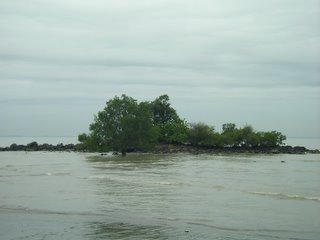
i went to the shore behind of my primary school, SRJKC Yok Poon on 18 November 2005. This was the first time i went to this shore again ever since i grown up. My last visit was probably few years back!
The different of this visit after so many years was, now, i am able to recognise most of the marine creatures i saw! Thanks to the trainees from Check Jawa and Semakau. :)
Unfortunately, i forgot about the nasty sand fries of this shore. i got a few nasty bites during my visit and the bites itched for a week. The scars from the bite (of course i would scratch since it was so itchy) lasted until now, after 3 weeks!
These are only a few pictures that i managed to take. Well, i am not a good photographer ,so do bear with the quality of the photos. Due to time constraint also, i did not wait patiently to take animal such as friddle crabs, mudskippers, gobbies ...
Next time then. (You do see me in need of helper right?)
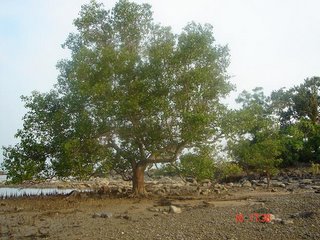
Soneratia (Perepat)
The nectar from this mangrove tree is the favorite food of a kind of bat.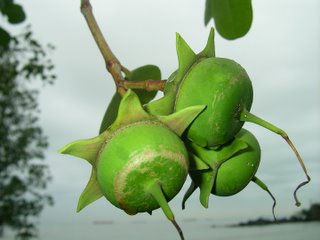

The fruits of Soneratia. It is edible.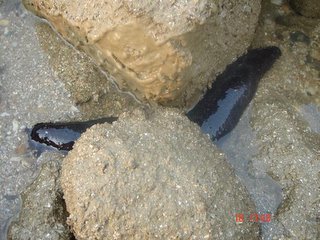 Black Sea Cucumber
Black Sea Cucumber
There are a lot of them anchor under of the rock.
i like the fact that there are bacteria staying near their anus for an easier source of food. :)
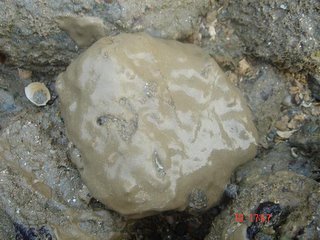 Hey, this is not a rock!
Hey, this is not a rock!
Doesn't it look like melt chocolate?
This is ascidian, an animal.
The baby ascidian in the free swimming larva form has notochord (vetebrate or back bone), but degenerates when it settle down.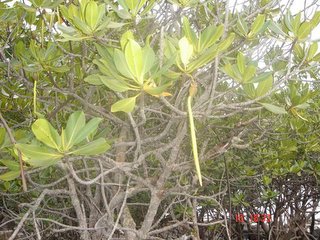 Rhizophora (Bakau)
Rhizophora (Bakau)
The seedings grow on the mother tree for a better surviving rate in the harsh environment at mangrove.
The timber can be used to construct kelong.
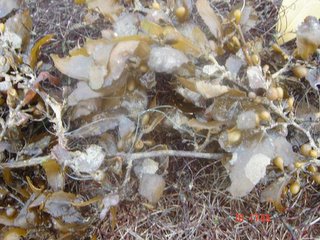 Sargassum (Brown Seaweed)
Sargassum (Brown Seaweed)
The air-filled bladders look like grapes!
The extract from the brown seaweed is used to make ice-cream, so that the ice cream taste or feel more smooth.

A clam in the pool of colonial anemone (the dot-like things).
When i was young, i thought these anemone were the eggs of frog. So i always thought there might be a kind of 'sea frog' laying eggs in the pool! LOL
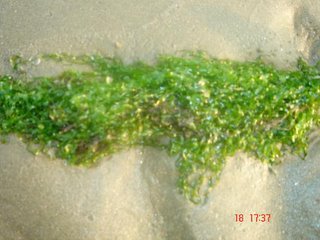
Sea Letuce (Green Seaweed)
Seaweed has no vein, no flower and no fruit.
 Red Seaweed
Red Seaweed
Sushi!
Japanese Nori is actually made from red seaweed.
A red seaweed might not looking red at all.

Sea Grass
On land, the cow eats grass. In the sea, the sea cow or dugong eats sea grass.
The sea grass is not the same as the grass on land. It lacks of a waxy-covering.
It feels slimy to touch.
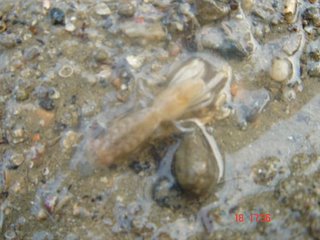
Snapping Shrimp
It makes the 'snap' sound when you walk at the shore. The sound is to stun prey or intimidate rival.
i used to think the 'click' sound i heard came from the clam opening or closing its shells or a crab opening or closing its pincer.

Drill
It eats barnacle. They can secrete asid to soften the hard shell of barnacle (drill a hole). It takes them probably 8 hrs to drill a 2mm thick of hole!
In the past, people extract purple color dye from drills.
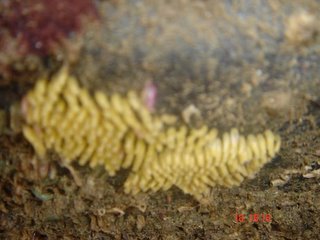
These are the egg cases of drill. The eggs are inside of the egg cases. The purple color one is the hatched larvae.
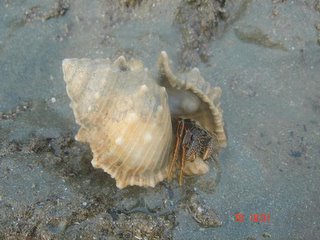
Hermit Crab
Its soft abdomen attached to the shell. So pulling it out by force will hurt it. Don't do this!
The hermit crab is not able to produce its own shell. So it will have to change to a new shell (shell from dead snails) as its size growing bigger and bigger. Collecting shells from the beach is depriving the hermit crabs from getting a suitable home.

Crab
The crab is in a defensive position.
There are abundance of them hide around the rocky shore. Please let them have a chance to grow bigger before you just snapped them and cooked them as your dish!
(i saw people collecting clam, so i think they might not spare the crabs if they found a suitable method to catch them.)

Dove Shell
This is a very tiny snail. Its shell is only around 1cm. It is omnivore (meat eater) and normally found at rocky area. Unfortunately live animals are becoming scarce.

Nerite
Take note of their streaming lines. The streaming lines prevent it from being sweep by away by the tide.
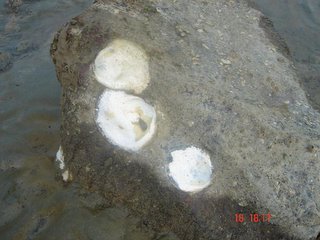
Oyster
Unfortunately, these were already opened up and harvested.
Oyster is bivalve (mollusc with two-part shells). One of the shell sticks tightly on rock.
A live oyster has rough and uneven shell while a died one (normally because of harvested by human being) has its smooth inner side of the shell exposed.


1 comment:
Do you have copy writer for so good articles? If so please give me contacts, because this really rocks! :)
Post a Comment